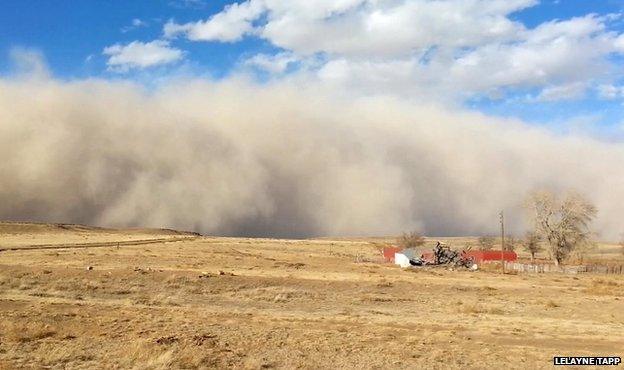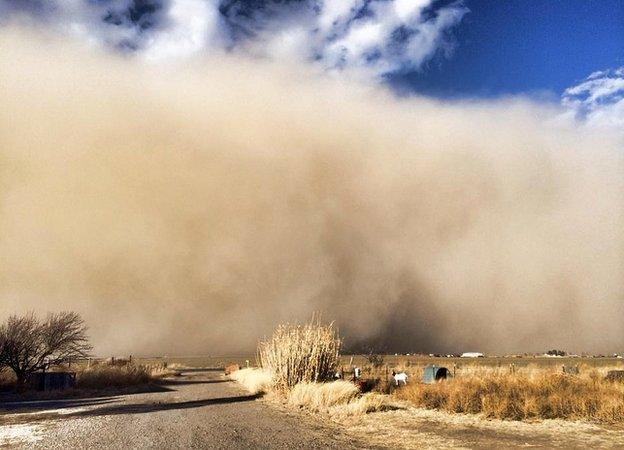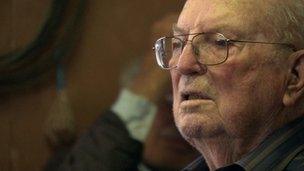Oklahoma drought kindles spectre of 1930s 'Dust Bowl'
- Published
- comments
How the drought is affecting crops and the land in Oklahoma
A menacing cloud of dust swirling above a parched field in Oklahoma is a disturbing reminder of the power of drought.
All too often here, when the land is baked dry, the winds can strip away an inch of precious topsoil in as little as 24 hours, soil that has taken centuries to form.
In the course of the most arid years, each acre of farmland can lose up to 70 tons of soil and then, wherever the dust is dumped, it can smother the crops it lands on.
In the Oklahoma Panhandle, the most remote area of the state, recent rainfall has been so meagre that fears have been kindled of a return to the apocalyptic "Dust Bowl" scenes of the 1930s.
Back then, agriculture collapsed and thousands of people left.
A survivor of the 1930s, 101-year-old Millard Fowler, who recalls sheltering from the "rolling black clouds" of the Dust Bowl, has seen similar conditions this year.
"Somebody asked me the other day if dust storms would happen again and I said 'they already have' - we've had some pretty good dust storms this spring," he said.
One of the worst was filmed by a local woman, LeLayne Tapp, and the video showed dust engulfing the community of Boise City, turning the sunlight orange and making roads impassable.
A farmer, JB Stewart, surveying one of his ruined wheat fields, told me that he had seen many droughts in his lifetime but the current one was "insane" because it has lasted so long.
"I've seen droughts over 50 years but nothing as devastating as what we've had in the last two to three years - I've never heard of anything like what we've had," he said.
His son Jarod, the fifth generation of the family to farm this land, said: "We've lost the crop and we've now got to figure out how to stop the soil from blowing.
"I'd compare it to the death of a loved one - you nurture this crop and invest in it and then you watch that crop die, it's devastating."
Across many parts of the state, the drought is acknowledged to have started three-and-a-half years ago with between 30-50 inches less rainfall than on average over that time.

One recent dust storm was captured on mobile phone camera footage

The dust blocked out sunlight, turning the sky yellow

Residents have been shocked that rainfall has been so poor
Gary McManus, the Oklahoma State Climatologist, told the BBC: "The drought right now is the worst in decades especially in western Oklahoma.
"This has had a big economic impact on our economy - if you look at agriculture in 2011-12 alone there were $2bn losses from crops and cattle."
He highlights rainfall statistics for the weather station in Boise City in the midst of one of the hardest-hit areas, Cimarron County, where the total from October 1 2010 to June 12 2014 was just 43 inches.

101-year-old Millard Fowler lived through the 1930s Dust Bowl period
By comparison, over the same period in the 1930s, a time of extraordinary hardship, Boise City received only 41.62 inches of rain.
Back then, massive dust storms destroyed such vast areas of farmland that a journalist, reporting on what became an environmental and human catastrophe, coined the term "Dust Bowl".
Years of drought, exacerbated by poor farming practices, left the fields without vegetation or any form of protection, so the soils were vulnerable to the winds.
In one notorious storm in April 1935, dust was swept all the way to Washington DC, where it alerted the federal authorities to the unfolding nightmare.
The wrecking of harvests and the crushing of livelihoods were then seared into the national memory in literature such as John Steinbeck's Grapes of Wrath, with its account of the plight of the Joad family.
Since then, important changes in farming policy have lessened the impact of the drought.
.jpg)
The current situation has raised fears of a return to the 'Dust Bowl' conditions of the 1930s
The technique of "no-till" agriculture - in which ploughing is avoided and stubble is deliberately left standing in fields - reduces the amount of farmland exposed to the winds.
And farmers can now buy government-supported crop insurance and receive grants for planting farmland with natural grasses which are better able to withstand drought.
But what has shocked many in this region is that rainfall has been so poor that even some of the best-kept fields have become miniature dust bowls.
Rick Kochenower, an agronomist with Oklahoma State University, developing new techniques of crop rotation and water conservation, said conditions were "scary" and "make you feel helpless".
"We try to do the right things and have modern technology but Mother Nature still dictates what happens, she's the driving force - all plants require water to grow," he said.

Dr Renee McPherson says the region could see increased drying as temperatures rise
A key question is whether future droughts will become more intense.
The farmer, JB Stewart, wonders if a long period of good rainfall that he enjoyed in the 1970s and 80s means there can be an equally long period of poor rain in decades ahead. Others avidly follow reports of a stirring El Nino, which could bring moisture to Oklahoma.
Dr Renee McPherson of the University of Oklahoma was an author of the Great Plains chapter of the recent National Climate Assessment.
She says the region experiences very large climate variability but that models suggest there will be a rise in maximum temperatures this century.
That could increase evaporation from the ground and transpiration from plants.
"We're less sure of what will happen to our precipitation patterns, but even if they stay the same, we'll see increased drying with those increased temperatures," she explained.
"We aren't sure what the droughts will look like in future - whether they'll be longer - but we feel that because of the increasing temperature they will be intensified."
Millard Fowler, the Dust Bowl survivor, worries that although farmers are supported, life will become tougher as supplies of groundwater, used for irrigation, run low.
He said: "There's very few living out on the farms anymore - they moved to towns where they could get television."